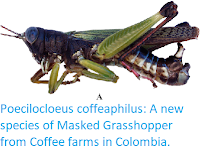In the 1980s, the Institut de Reserche pour le Developpement carried out fieldwork in the rainforests of Cameroon and the Republic of Congo (Congo-Brazzaville), searching for new species and strains of Coffee. A large number of specimens were collected, several of which were considered to be representatives of new species, but none were formally described at the time, and the absence of fruiting or flowering specimens meant that none were included in a major review of the genus Cofea in 1998. However, subsequent additional collections have resulted in two of these species being formally described, Cofea charrieriana from southwest Cameroon in 2008 and Cofea anthonyi from Cameroon and the Republic of Congo in 2009.
In a paper published in the journal Adansonia on 21 December 2021, Piet Stoffelen of the Meise Botanic Garden, François Anthony of the Unité Mixte de Recherche's Interactions Plantes-Microorganismes-Environnement at the Institut de Reserche pour le Developpement, Steven Janssens, also of the Meise Botanic Garden, and Michel Noirot, also of the Unité Mixte de Recherche's Interactions Plantes-Microorganismes-Environnement at the Institut de Reserche pour le Developpement, describe a new species of Coffee from Mount Kupe in Cameroon, based upon samples collected in 1983 and cultivated at the Meise Botanic Garden, plus additional material collected in 2012, and placed in the Bassin Martin Coffee Collection.
The new species is named Coffea rizetiana, in honour of Georges Rizet of the Orsay University Paris XI, for his role in the 1980s expeditions. It is a small tree, reaching about six metres in height, with elliptical leaves about 6-9 cm long when fully grown, which produces large white flowers and distinctive black fruit, almost spherical and up to 2.3 cm long (this is distinctive among Coffee plants, which tend to have smaller fruit, which are red when ripe).
Coffea rizetiana, (A) habit; (B) node with flowers and petioles; (C) detail of flower; (D) fruit; (E) transection of the fruit with two seeds. Scale bars: (A) 3 cm; (B) 2 cm; (C)-(E) 1 cm. Antonio Fernandez in Stoffelen et al. (2021).
Coffea rizetiana has only been recorded growing in a single location, in the south of the Mouyouka-Kompina Forest, on the lower flanks of Mount Kupe, at an altitude of about 60 m. This area has since been cleared for agriculture, and the species is thought to be extinct in the wild, with surviving specimens growing in cultivation on Réunion Island and at the Meise Botanic Garden. It is likely that the distinctive fruit of Coffea rizetiana were consumed (and its seeds scattered by) different Animals than other species of Coffee growing in the area, though this is now impossible to judge.
Coffea rizetiana fruit showing its basis (right) and top (left) from the Coffea collection at Bassin Martin (Réunion, France). Stoffelen et al. (2021).
Mount Kupe appears to be somewhat of a hotspot for the genus Coffea, with at least six species growing on or close to its flanks. Coffea rizetiana formerly occupied the understory of the lowland forest on the mountain's lowest flanks. Coffea brevipes is only found on the drier north face of Mount Kupe, although this is otherwise a fairly environmentally tolerant species, found across a wide area of the lower Guinean and Congolian forests. Coffea montekupensis is found on the wet western and southern slopes of Mount Kupe at an elevation of 800 m to 1500 m; this species is found at similar altitudes at other sites in the Bakossi Mountains. Coffea bakossii is found growing at several locations between 700 and 900 m above sealevel; this species is also found elsewhere in the Bakossi Mountains, but is generally considered rare. Coffea liberica appears to grow all over the mountain, with no apparent favoured niche. This is unsurprising, as this is a widespread species found throughout the Guineo-Congolian lowland to submontane forests. Finally, the cultivated Coffea canephora (Robusta Coffee) is grown on the lowland forests surrounding the mountain; despite being grown in the area for about 50 years, this species does not appear to have naturalised to the area, and is not found growing away from Coffee plantations. At least another six species of Coffea are found growing in the forests of southwest Cameroon, leading Stoffelen et al. to recommend that the area should be targeted as a priority for conserving the wild biodiversity of the genus.
See also...



Follow Sciency Thoughts on Facebook.
Follow Sciency Thoughts on Twitter.





